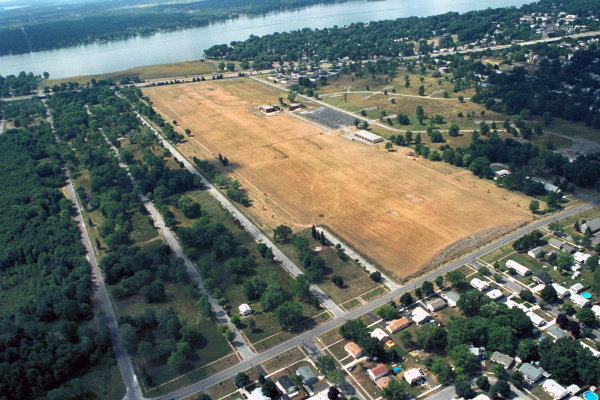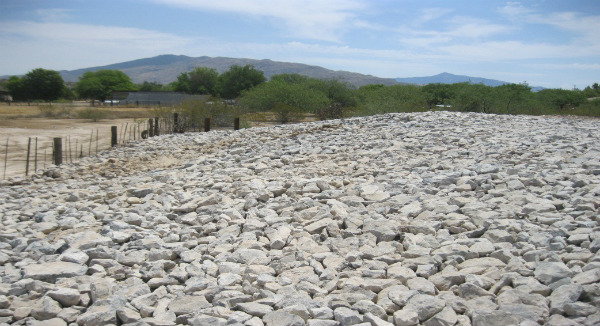40th anniversary of an environmental disaster
By David M. Brown
“None of us want to see another community go through what this community has endured . . .” – Pete Lopez, EPA Region 2 Administrator Luella Kenny, wheeling her toddler son, Jon Allen, in a stroller, wondered what the large open area was in her densely populated neighborhood in upstate New York. “I had no knowledge of Love Canal until the articles appeared in the newspaper in the late 1970s,” she recalled.
She found out, and the country found Love Canal.
Macabrely ironic in name, Love Canal was a short-lived 19th-century hydroelectric and model city project four miles south of Niagara Falls, which attracts myriads each year to upper New York State for misty-eyed sightseeing.
Forty years ago, Love Canal became an environmental nightmare, when approximately 22,000 tons of hazardous chemicals, which had been dumped decades before, were widely publicized as seeping into the homes at the working-class community. The event awakened America.
“The human toll was enormous. Sickness was seen throughout the community: heart disease, cancer, rashes, kidney, allergies, immune diseases and on and on,” said Kenny, who lived there with her family in a home on a quiet acre next to a creek from 1969 to 1979.
“Families were in upheaval. There were many divorces because the males of that era felt it was their responsibility to provide housing for the family,” she explained.
Some left their homes, while others pleaded to state and federal agencies to visit their community and see what environmental carelessness and social irresponsibility create.
Most of her neighbors stayed, especially the older ones; other neighbors committed suicide. Children were separated from their friends. Babies were born with birth defects. Jon Allen died at 7 from minimal lesion nephrosis, a failure of the immune response to
develop.
Their backyard revealed 32 parts-per-billion (ppb) of dioxin, said Kenny, a cancer research scientist. Her husband was a chemist. “We researched our son’s disease and found medical journal citations that showed his disease was related to dioxin exposure,” she explained, noting that acceptable levels are 1 ppb or less.
Her husband had a pre-existing heart condition. “When his cardiologist found out where we lived, he told us we could not stay,” Kenny recalled.
After moving from their home at Love Canal, the family lived in a hotel and in air base housing until January 1981, when they were able to buy another home. Two surviving sons were born away from Love Canal, Christopher and Stephen.
Other carcinogens in the neighborhood included halogenated organics and chlorobenzenes as well as heavy metals and hazardous waste. Children played in the standing pools of toxic goo, as chemicals seeped into the homes. The 70-acre site has since been capped and is monitored, but most of the chemicals remain.
David Axelrod, New York’s then Department of Health Commissioner, said that Love Canal was a “national symbol of a failure to exercise a sense of concern for future generations.”
CANAL TO HELL
William T. Love began excavating the canal in the 1890s. But a variety of factors made this unrealistic as a business venture. The land was sold to the Hooker Chemicals & Plastic Corp., now part of Occidental Chemical Corporation. The company buried the waste in
legal steel drums on the site from 1942 to 1953, capping it in clay.
The land was then “sold” to the Niagara Falls School Board for one dollar – with the stipulation that the company would not be liable if some of the chemicals leached out.
Residents began reporting odors and residues as early as the 1960s. Those unusually wet, snowy winters in the late 1970s then lifted the water table, and the chemicals in the old and breached containers entered basements and yards as well as the playground of
the elementary school that had been built above the canal, explains Dr. Jordan Kleiman of SUNY Geneseo in “Love Canal: A Brief History” (2018).
The working-class residents formed the Love Canal Homeowners’ Association and fought a two-year-plus battle, recalled Kenny, who today lives on Grand Island, New York, in the Niagara River between Niagara Falls and Buffalo. “We had a goal of evacuation and would not settle for anything less. The state tried to get us to accept less, but we held out,” he said.
Officials finally heard the cries and ordered the relocation of 239 families on August 2, 1978. President Jimmy Carter declared Love Canal a federal disaster site, which helped the families with relocation costs. A second state of emergency followed in 1981, when the
remaining families were relocated.
Owned by the Niagara Falls Board of Education, the 70-acre dump site is now fenced in chain link –– almost two decades following EPA remediation.
“I will never forget going to the Love Canal neighborhood, shortly after its evacuation, as a nearly rookie reporter,” recalled Dan Herbeck, with The Buffalo News for 42 years. “It looked like a ghost town: hundreds of abandoned ranch homes in what was once a thriving neighborhood, full of families and activity.
“I remember the looks of fear and concern on the faces of mothers whom I interviewed around that time, women who had lived for years near a dangerous chemical dump with their husbands and kids. These women were elated that the government was moving them out of that neighborhood but also very apprehensive about what the future held,
especially for their kids,” Herbeck said.
LOVE CANAL LESSONS
With added public awareness of other contemporaneous environmental disasters, such as the Valley of the Drums in Kentucky, Love Canal intensified environmental activism and inspired federal legislation to clean up the sites and find the perpetrators.
One result was the Comprehensive Environmental Response, Compensation, and Liability Act (CERCLA) — better known as Superfund — which became law on December 11, 1980. Under its directives, sites significantly threatening public health and the environment are placed on the National Priorities List (NPL). Today in Arizona, nine NPL Superfund sites are in various stages of remediation.
Other good has come: EPA data shows that during fiscal year 2017, approximately 6,600 businesses at 487 Superfund sites in reuse generated $43.6 billion in sales and employed 156,000 people who earned a combined income of $11.2 billion.
Superfund cleanup construction work at Love Canal was completed in 1999, and EPA deleted it from the NPL in 2004 after final review. The agency continues to monitor the site in five-year increments known as “Five Year Reviews,” explained Mike Basile, Region 2 public affairs specialist in Buffalo.
“Over the past 15 years or so, the federal and state governments have declared Love Canal a ‘safe’ neighborhood,” says Herbeck, who lives in Tonawanda, N.Y., a suburb of Buffalo, about a half hour from Love Canal. “They changed the name to Black Creek Village and allowed hundreds of families to move back in, buying those long-abandoned homes at bargain prices.”
If you visit, he explains, you see young families, Little League Baseball fields, a playground and a senior citizens center within a quarter mile or so of where thousands of tons of dangerous chemicals are still buried. “I still shudder when I see the playground that is built right next to the Love Canal fence and I see mothers bring their small children there,” Kenny says.
Herbeck has recently interviewed families who complain of strange smells and chemicals seeping into their basements, reminiscent of 40 years ago, and lawsuits have been filed by residents and former residents, claiming Love Canal is still poisoned.
“The government insists this is a safe site, one of the most tested and closely monitored neighborhoods in America,” he says. “Is it safe? I am just a news reporter; I honestly don’t know. Would I want my kids and grandchildren to live there? No.”

LOVE CANAL LESSONS: ARIZONA
Some states, including Arizona, established clean-up programs after Love Canal to assist the EPA with these nationally designated sites as well as manage local programs. In Arizona, this is the Arizona Department of Environmental Quality, begun on July 1, 1987.
One program managed by ADEQ is the Water Quality Assurance Revolving Fund (WQARF), begun in 1986 and revised in 1997. Arizona now has 36 WQARF sites.
“You might call it ADEQ’s Superfund program; it’s loosely based on CERCLA,” explained Laura Malone, Waste Programs Division Director since October 2012.
“With any sad event comes learning, and Love Canal made for lots of learning,” she said. “As devastating as it was, Love Canal helped spark awareness and the environmental movement throughout this country, so that, working together, we can prevent another tragedy like this one.”
Today, four decades later, we are all Luella Kenny. “We thought this was an idyllic place to raise our family,” she said of her Love Canal home, on a quiet acre by the creek. “How wrong we were.”
Among many resources are www.epa.gov/superfund and azdeq.gov. Area resident and activist, Lois Gibbs, has written Love Canal: My Story (1982).
Brown is a Valley-based writer (azwriter.com). All photos courtesy of ADEQ.








